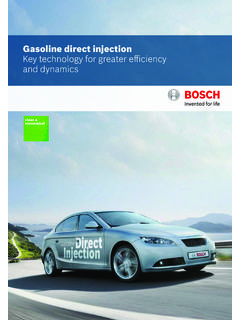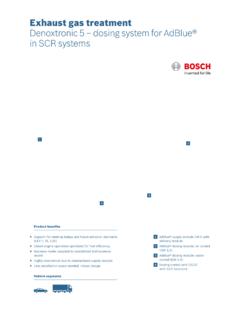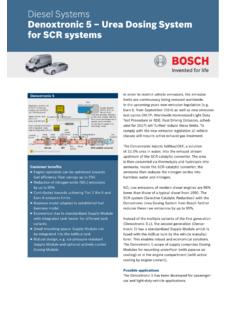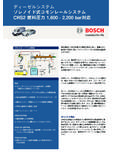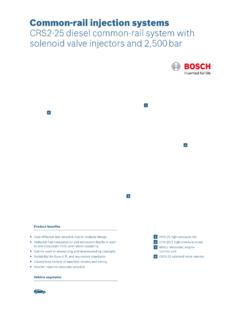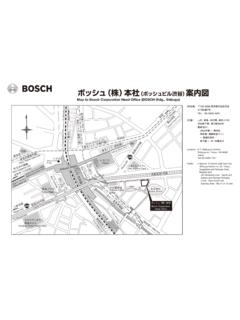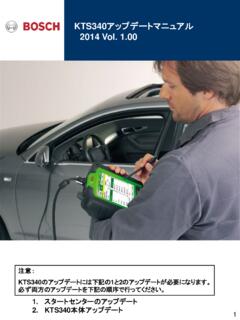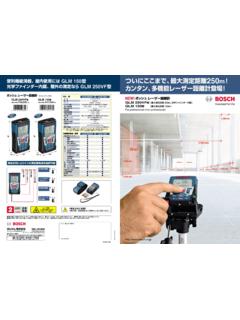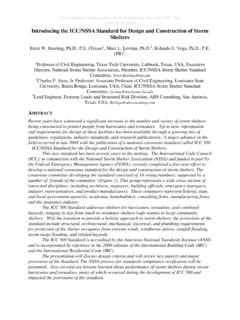Transcription of Sensors for exhaust-gas treatment systems - …
1 Diesel SystemsSensors for exhaust -gas treatment systemsAll functions from mixture formation to exhaust -gas treatment rely on precise, constantly updated data from the exhaust tract. This data is provided by Sensors developed by Bosch specifically for this next stages of and EU emission legislation will stipulate the ability for comprehensive exhaust -gas treatment system diagnosis in order to ensure compli-ance with emission targets over the vehicle s mixture formation, which is controlled by the EDC Electronic Diesel Control, is an important factor for reducing the pollutant content of the engine s raw emissions. The control for minimizing tolerances in raw emissions is supported by the lambda sensor with pre- cise metering of the residual oxygen in the exhaust gas. Bosch offers fuel-efficient solutions for the operation of closed particulate filters. As soon as the particulate filter (DPF) is fully loaded it has to be regenerated by burning the stored particulate matter.
2 The solution is built upon software functions based on the evaluation of sensor signals. A differential pressure sensor is used to monitor DPF loading and functionality at the same restrictions in emissions legislation will require additional Sensors , including the NOX sensor and the particulate matter applicationsBosch exhaust Sensors can be applied in every con-ceivable diesel system configuration for the fulfillment of ambitious emission in the diesel exhaust systemEngine Control Unit incl. SCR functions (optional in DCU)ActuatorsEngine CANS ensorsLambda sensorOxi sensorPM sensorNOXsensorAdBlue/DEF Dosing ModuleAdBlue/DEF tank unit with Supply Module, heated reservoir, splash guard, pressure, temperature and level sensorsSCR catNOX sensorCustomer benefits Clean and economical engine operation thanks to the provision of all required data High measuring precision Adherence to current and future emission standards and OBD regulations (On-Board Diagnosis) Emission targets: Euro 5, Euro 6, CARB MY2013112233 Sensors for exhaust -gas treatment systems NOX sensor Particulate matter sensor Lambda sensor LSU Differential pressure sensor 44 Robert Bosch GmbHDiesel SystemsPostfach 30 02 2070442 StuttgartGermanyFax: +49 711 811-45090 Printed in Germany292000P0VX-C/CCA-201203-En Robert Bosch GmbH 2012.
3 All rights reserved, also regarding any disposal, exploitation, repro-duction, editing, distribution, as well as in the event of applications for industrial property sensorThe NOX sensor supports control of the required urea dosing in SCR systems for NOX reduction and monitor-ing (OBD) of the SCR components. The ceramic sensor element works on the amperometric double chamber principle; it measures the NOX content in the exhaust gas. The sensor is available for passenger car and commercial vehicle matter sensorThe particulate matter sensor enables diagnosis of the particulate filter. It is integrated into the exhaust tract downstream of the filter. The sensor function is based on resistance measurements: Adsorbed soot particles form conductive paths between electrode combs on which an electric current is flowing. The sensor element is regenerated regularly by heating. The diagnostic software uses the measured current to evaluate DPF functionality.
4 This sensor is available for passenger car and commercial vehicle sensor for diesel enginesThe wide-band lambda sensor measures the residual oxygen content in the exhaust gas and helps to comply with strictest exhaust and OBD regulations. At the heart of the sensor is a planar sensor element with integrated measuring cell and heater. The measured data serves to adjust the optimal air-fuel mixture via the air-intake system . The latest-generation lambda sensor is specifically adapted to customer require-ments regarding diesel engines. Differential pressure sensorThe differential pressure sensor measures the exhaust pressure difference across the particulate filter using a piezo-resistive sensor element. The measured value can be used to calculate the loading stage of the filter. This is the precondition for demand-controlled, fuel-saving particulate filter systems | Sensors for exhaust -gas treatment systemsBosch: Automotive competence from a single source Comprehensive range of services and know-how system and network competence Innovator and technology leader Warrantor for quality and dependability Worldwide presence Universal partnerCustomer benefits particulate matter sensor Compliance with upcoming legal regulations on On-Board Diagnosis Monitoring of DPF ageing system competence in diagnosis function and sensor technology Flexible application due to CAN interfaceCustomer benefits lambda sensor LSU Reduction of engine emission scatter by up to 50% Robust design.
5 Thermal shock and soot resis-tance, heating voltage reserve Benefits and features differential pressure sensorPressure range 0 - 100 kPa (differential) 0 - 125 kPa (relative)Response time < 1 ms Enables fuel-saving, demand controlled particulate filter regenerationCustomer benefits and techn. features NOX sensorNOX measuring range 0 - 1,600 ppmMeasuring precision 10 ppm system competence in monitoring and controlling the SCR system by precise measurement of exhaust -gas NOX content Fast operational availability, good signal dynam-ics, continuous signal availability and high robust-ness in the exhaust stream Flexible application due to CAN interfac
